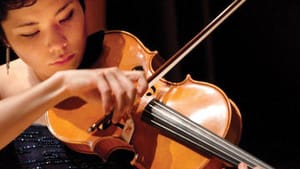Stay in the Loop
BSR publishes on a weekly schedule, with an email newsletter every Wednesday and Thursday morning. There’s no paywall, and subscribing is always free.
A dazzling viola debut (and that’s no joke)
Ayane Kozasa viola debut at Trinity Center

Violists are a thick-skinned bunch. They have to be; their instrument is the butt of many jokes (e.g., what’s difference between an onion and a viola? Nobody cries when you chop up a viola). But Ayane Kozasa had the last laugh at her Philadelphia debut recital.
She opened her wonderfully varied program with a downright dare, playing a transcription for viola of one of the most sanctified of all solo violin works: Bach’s Partita No. 2. She played it with such vibrant tone and multi-hued color that one could forget the original version. What’s more, she found a broad narrative arc in the music, connecting this secular piece by Bach to the spiritual zeal of his religious works. The concluding Chaconne, one of the masterpieces of all baroque music, was delivered with an operatic scope of expression.
Hints of jazz and folk
Kozasa called on two fellow Curtis grads to assist her with the rest of the program. Michael Djupstrom based his Walimai for Viola and Piano on Isabelle Allende’s story by the same name. He took the piano part for this performance, which was well rehearsed, as the pair have played it together many times since they premiered it at Kozasa’s graduation recital.
This familiarity no doubt accounted for the rhapsodic treatment the music received. Composer Djupstrom employs an accessible language that’s flavored with hints of jazz and folk music, which accounts for the rather exotic sense of the piece. Pianist Djupstrom added sinew and sparkle to the proceedings.
After the intermission, Kozasa’s other Curtis chum, cellist Gabriel Cabezas, joined her for an early work by Beethoven, a duo for viola and cello that oozes with charm, especially so in their sprightly and beautifully coordinated performance.
Syncopated rhythms
Cabezas remained for a new piece, Limestone & Felt, by the New York-based composer Caroline Shaw. As its title suggests, this piece is a study in instrumental texture, at its most evocative when the two players trade off delicate strands of pizzicato runs and syncopated rhythms. The piece exudes has a toccata-like energy, but at a lower volume.
Djupstrom returned as pianist for Kozasa’s dazzling closer, Paul Hindemith’s 1919 Sonata for Viola and Piano. Hindemith is something of a patron saint for violists, as he contributed a healthy cache of music for the instrument to the repertoire. This sonata utterly contradicts Hindemith’s reputation for dry, dour music. The opening Fantasie has an easy lyricism that is reminiscent of Rachmaninoff.
The work concludes with two variation sets of wildly contrasting moods. Some of the faster music sounded like drunken folk dances, with pungent dissonances spiking up the energy. The piece’s momentum built to a raucous but ultimately joyous conclusion that swept the audience to its feet.
What, When, Where
Ayane Kozasa, viola, with Michael Djupstrom, piano, and Gabriel Cabezas, cello. Astral Artists program December 8, 2013 at Trinity Center, 2212 Spruce St. (215) 735-6999 or astralartists.org.
Sign up for our newsletter
All of the week's new articles, all in one place. Sign up for the free weekly BSR newsletters, and don't miss a conversation.
